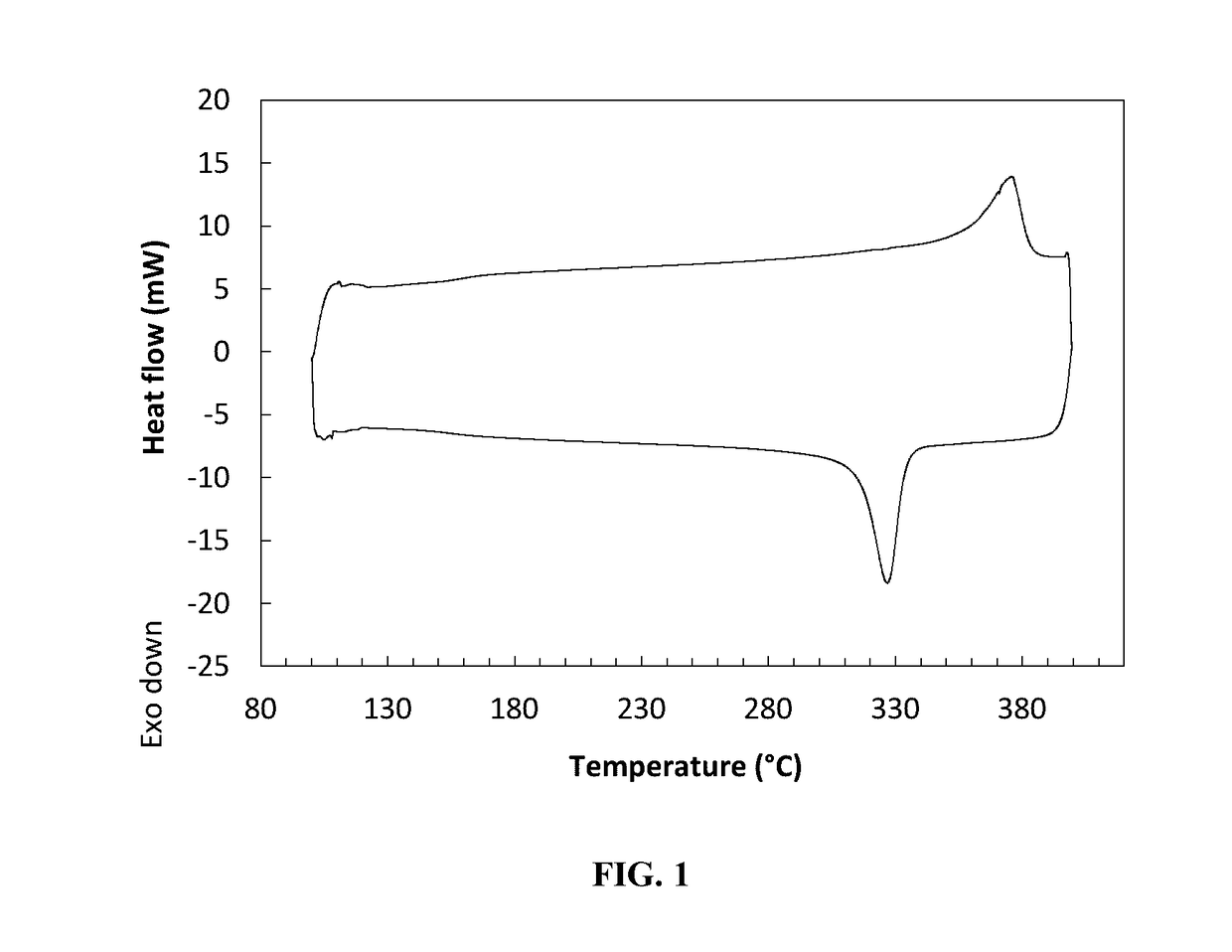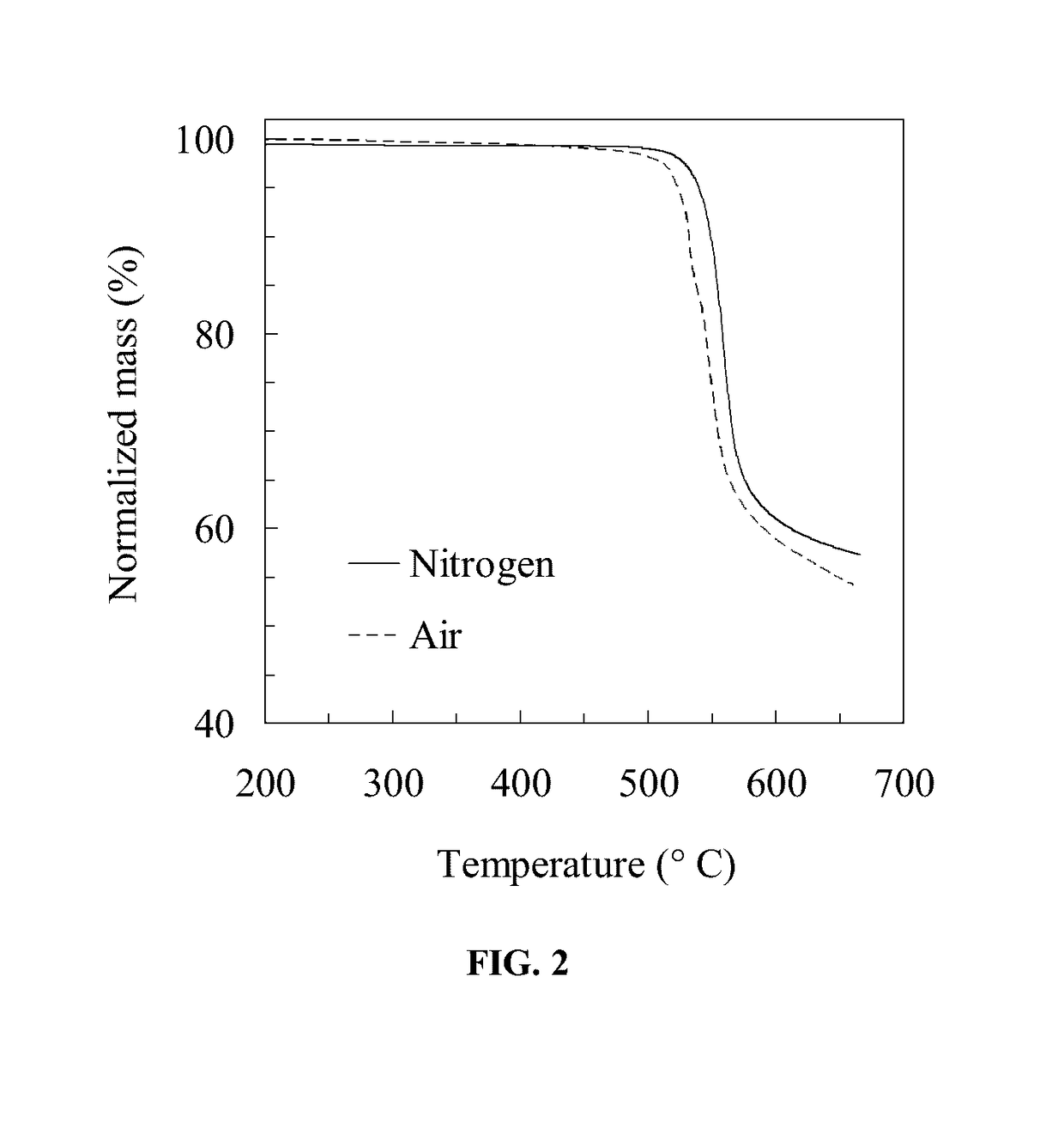Powder coating compositions for reducing friction and wear in high temperature high pressure applications
a technology of high temperature high pressure and composition, applied in the direction of polyether coating, machine/engine, synthetic resin layered products, etc., can solve the problems of high friction coefficient, high friction coefficient of the surface of the conventional metallic gate valve used in the oil and gas industry, and high friction coefficient of the surface. , to achieve the effect of low friction coefficient, low wear resistance and high mechanical strength
- Summary
- Abstract
- Description
- Claims
- Application Information
AI Technical Summary
Benefits of technology
Problems solved by technology
Method used
Image
Examples
example 1
Characterization of Crystallinity of the Thermoplastic Polymer
[0058]Differential scanning calorimetry (DSC) was performed using a TA Instruments Q100 differential scanning calorimeter for characterizing the glass transition, melting, and crystallization transitions of the thermoplastic polymer. PEEK (VICOTE 701 supplied by VICTREX in the form of 50 μm sized powder particles) was dried at 120° C. in a vacuum oven for 24 hours before the DSC analysis. The sample, which was loaded in a hermetically sealed aluminum pan, was heated and cooled at a constant rate of 25° C. / min over a temperature range of 100 to 400° C. The measurements were carried out under nitrogen flow, at a rate of 50 cm3 / min, through the furnace. Distinct melting and crystallization peaks were observed in the resulting DSC thermogram. FIG. 1 depicts data acquired during the second cycle of heating and cooling. A glass transition at approximately 175° C., a melting transition at approximately 375° C., and a recrystalli...
example 2
Thermogravimetric Analysis (TGA)
[0059]Thermogravimetry (TG) of a high molecular weight PEEK was conducted using a heating rate of 20° C. / min. The high molecular weight PEEK was found to have excellent thermal stability. FIG. 2 compares the thermogravimetric plots for PEEK, acquired by heating the polymer under an inert environment of nitrogen gas and an oxidative environment of air. The thermal stability of PEEK in air was slightly lower than that in nitrogen. However, the thermal decomposition temperature was sufficiently high such that the coatings can be used in high temperature applications or can be applied using thermal spray processes.
example 3
Particle Size Reduction and Compounding Using Ball Milling
[0060]The composite powders were prepared by ball milling in two steps. In the first step, PEEK (VICOTE 701 supplied by VICTREX in the form of approximately 60 μm sized powder particles, 75 g) was dispersed in ethanol (99.9% purity, 300 mL) and ball milled for 24 hours, in a U. S. Stoneware Jar Mill using a combination of steel balls of three different diameters (25, 15, and 10 μm). After milling, the solid was allowed to settle down, the supernatant ethanol was decanted, and the powder was dried overnight in a vacuum oven at 110° C. Ball milled powder of the cermet, WC / CoCr [WC-760, CAS no. 7440-48-4, consisting of tungsten (79.8 wt %), cobalt (10.7 wt %), carbon (5 wt %), and chromium (4.5 wt %), supplied by Praxair, Inc.], and the ceramic, hexagonal boron nitride (hBN, CAS no. 10043-11-5, supplied by Industrial Supply, Inc., Twin Falls, Id.) were prepared similarly Dry powders were obtained by evaporation of ethanol (from ...
PUM
| Property | Measurement | Unit |
|---|---|---|
| mean equivalent diameter | aaaaa | aaaaa |
| glass transition temperature | aaaaa | aaaaa |
| thickness | aaaaa | aaaaa |
Abstract
Description
Claims
Application Information
 Login to View More
Login to View More - R&D
- Intellectual Property
- Life Sciences
- Materials
- Tech Scout
- Unparalleled Data Quality
- Higher Quality Content
- 60% Fewer Hallucinations
Browse by: Latest US Patents, China's latest patents, Technical Efficacy Thesaurus, Application Domain, Technology Topic, Popular Technical Reports.
© 2025 PatSnap. All rights reserved.Legal|Privacy policy|Modern Slavery Act Transparency Statement|Sitemap|About US| Contact US: help@patsnap.com



